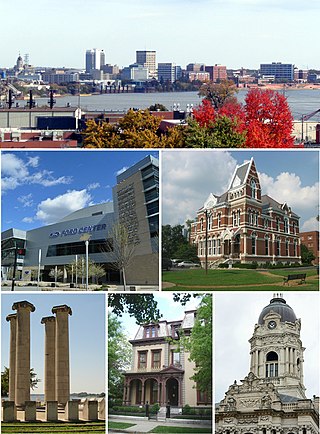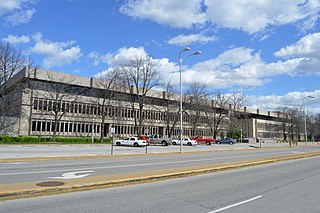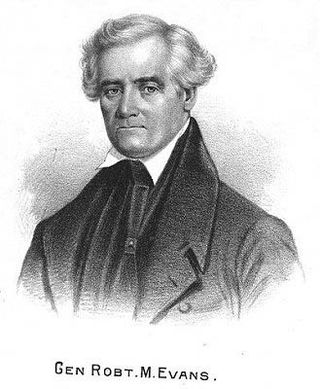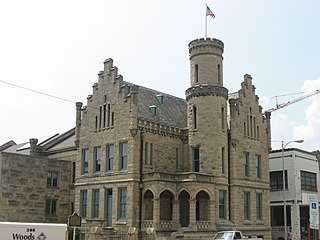
Vanderburgh County is a county in the U.S. state of Indiana. As of 2020, the population was 180,136. The county seat is in Evansville. While Vanderburgh County was the eighth-largest county in 2020 population in Indiana, it is also the eighth-smallest county in area and the smallest in southwestern Indiana, covering only 236 square miles (610 km2).

Evansville is a city in and the county seat of Vanderburgh County, Indiana, United States, with a population of 118,414 at the 2020 census, making it the state's third-most populous city after Indianapolis and Fort Wayne, the largest city in Southern Indiana, and the 249th-most populous city in the United States. It is the central city of the Evansville metropolitan area, a hub of commercial, medical, and cultural activity of southwestern Indiana and the Illinois–Indiana–Kentucky tri-state area, that is home to over 911,000 people. The 38th parallel crosses the north side of the city and is marked on Interstate 69.

The Old Vanderburgh County Courthouse, often simply called the "Old Courthouse," was once the center of Vanderburgh County, Indiana government. Construction started in the spring of 1888 and was completed in November 1890. The building was ready to be occupied by the county government in early 1891. It sits in the heart of downtown Evansville.
WNIN is a PBS member television station in Evansville, Indiana, United States. Owned by WNIN Tri-State Public Media, it is sister to NPR member station WNIN-FM (88.3). The two outlets share studios in downtown Evansville and transmitter facilities near Pelzer, Indiana.
Benjamin Bosse High School, referred to as Evansville Bosse High School by the IHSAA, is a public high school of the Evansville Vanderburgh School Corporation in Evansville, Indiana, United States. Bosse is the third smallest high school by enrollment of Vanderburgh County's nine high schools. The school is a contributing property to the Lincolnshire Historic District on the National Register of Historic Places.

The Riverside Historic District is a U.S. historic district located in downtown Evansville, Indiana. It was added to the register in 1978 and roughly bounded by Southlane Drive, Walnut, Third, and Parrett Streets. It consists of 1,010 acres (4.1 km2) and 425 buildings. It is also known as the Riverside Neighborhood.

Center Township is one of eight townships in Vanderburgh County, Indiana, United States. As of the 2010 census, its population was 39,007 and it contained 16,306 housing units.

Downtown Evansville is the central business district of Evansville, Indiana. The boundaries of downtown Evansville have changed as the city has grown, but they are generally considered to be between Canal Street at the south and east, the Lloyd Expressway to the north, Pigeon Creek to the northwest, and the Ohio River to the southeast south and southwest. Downtown Evansville is entirely within Pigeon Township.

The Evansville Civic Center Complex is the location of all city offices for the City of Evansville and County of Vanderburgh, including the Evansville Police Department and the Vanderburgh County Sheriff's Department. The Vanderburgh County Courts System is in the Northeast Building. The EVSC headquarters is in the eastmost building. The complex is bounded by Sycamore Street to the northwest, SE Ninth Street to the northeast, Locust Street to the southeast and M.L. King Boulevard to the southwest.

This is a list of the National Register of Historic Places listings in Vanderburgh County, Indiana.

The Soldiers and Sailors Memorial Coliseum is a multi-purpose auditorium and meeting space in downtown Evansville, Indiana.

The Willard Carpenter House, located at 405 Carpenter Street in downtown Evansville, Indiana, is one of two landmarks recognized as memorials to one of the city's most influential pioneers, philanthropist Willard Carpenter. The other is Willard Library which he built, endowed and gave to the people of the area. Willard Carpenter, born on March 15, 1803, at Strafford, Orange County, Vermont, was a son of Willard, Sr., and Polly (Bacon) Carpenter, and a descendant of the noted Rehoboth Carpenter family.

General Robert Morgan Evans was born in Frederick County, Virginia. In 1803 in the town of Paris, Kentucky, he was married to Jane Trimble, a sister of Judge Robert Trimble of the Supreme Court of the United States. Evans, for whom Evansville, Indiana is named, did not actually found the city, but his influence played a role in determining the future of the town. He was the tenth Speaker of the Indiana House of Representatives.

James William Reid (1851–1943) was a Canadian-born American architect of the noted San Francisco firm of Reid & Reid.

The Carnegie Library is a historic Carnegie library located at Muncie, Indiana, United States. The building houses the Local History & Genealogy collection and an open computer lab. The facility also provides wireless access and a meeting room for local groups to reserve. It is one of four branches that make up the Muncie Public Library System. The building was made possible through a financial donation to the City of Muncie by Andrew Carnegie to expand their library system throughout the community. The foundation for Carnegie Library was built in 1902 and the building opened to the public in 1904. It has been in continuous use as a library since its opening. The building is located in downtown Muncie at the intersection of Jackson and Jefferson.

Shopbell & Company was an American architectural firm located in Evansville, Indiana, in the United States.

Lamasco is a former town, and current district, in Evansville, Indiana originally bounded by the present day streets of St. Joseph Avenue on the west, First Avenue on the east, Maryland on the north and the Ohio River on the south to Fulton. Lamasco includes the Independence Historic District, which was placed on the National Register of Historic Places in 1982. Part of this historic district includes West Franklin Street, a retail and service center with a 100-foot-wide street that plays host to the annual West Side Nut Club Fall Festival.

The Evansville Vanderburgh Public Library (EVPL) is a public library system serving Evansville and Vanderburgh County in Indiana, USA. The EVPL also supplements the services provided by the Evansville Vanderburgh School Corporation and has the authority to approve the tax levy of the independently run and operated Willard Library.

Former Vanderburgh County Sheriff's Residence is a historic jail and sheriff's residence located in downtown Evansville, Indiana. It was built in 1891, and is a 2+1⁄2-story, rusticated limestone building modeled after Schloss Lichtenstein. It features a central round tower or "keep", stepped gables, crenellated roofline, and turrets.

Louisville and Nashville Railroad Station, also known as L & N Station, was a historic train station located in downtown Evansville, Indiana. It was built in 1902 for the Louisville and Nashville Railroad, and was a Richardsonian Romanesque style rock-faced limestone building. It consisted of a three-story central block with two-story flanking wings, and a one-story baggage wing. It had projecting gabled pavilions and a slate hipped roof.






















